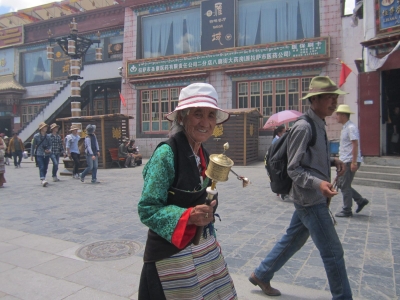'Roof of the World' no more an enigma now!
By IANS | Published: July 25, 2021 08:33 AM2021-07-25T08:33:03+5:302021-07-25T08:50:18+5:30
Dharamsala, July 25 Over two-thirds the size of India, Tibet, also known as the 'Roof of the World' ...

'Roof of the World' no more an enigma now!
Dharamsala, July 25 Over two-thirds the size of India, Tibet, also known as the 'Roof of the World' or 'Third Pole of the Earth', may no more be an enigma for the outside world now.
For, China has opened its door to the tourists after keeping the Tibet Autonomous Region in the southwest, the land rich in minerals and a variety of flora and fauna, out of bounds for ages.
President Xi Jinping last week made an unannounced visit to the politically sensitive region of Tibet, the first by a Chinese leader in more than 30 years.
Besides visiting Nyingchi, a strategically located border town close to Arunachal Pradesh, and the regional capital Lhasa, Xi inspected a number of key local infrastructure projects, including the Lhasa-Nyingchi section of the Sichuan-Tibet railway project.
As per the regional tourism development department, the traditional culture-dominated Tibet Autonomous Region is seeing a tourism boom with a record 17.58 million trips made by visitors in the first six months this year, up 110.9 per cent year-on-year growth.
It says the opening of the Lhasa-Nyingchi railway, the first electrified railway on June 25, has injected new vitality into the development of Tibetan tourism.
Tibet saw more than 35 million tourists in 2020 despite the pandemic, up from 1.8 million tourists in 2005, according to the local government.
But for the foreign journalists and government dignitaries it's still off-limits, fearing backlash for seizing control of the Tibetan monasteries and expanding Chinese education rather than the local language.
A small group of foreign journalists every year gets a rare opportunity to visit the Tibetan plateau barren and ringed by dense groves at the invitation of the Chinese government to showcase the progress Tibet has made since the Chinese ‘takeover'.
This correspondent was part of the foreign media tour of Tibet in the recent past.
The tastefully lit square with magnificent fountains facing the famed, majestic Potala Palace, once the seat of the Dalai Lama, is the most visited place, especially in the evening.
In Lhasa, which in Tibetan language means holy land, the sun sets normally in summer at around 9 p.m.
Transcending geographical barriers, Hindi movies and love songs make their presence felt in mobile ringtones and even the lips of the Chinese youth in Tibet.
When this correspondent visited the Beijing Experimental School in Lhasa, a big screen at the entrance showcased students swaying to the "Chaiyya chaiyyaa" song from the Shah Rukh Khan-starrer Hindi film "Dil Se".
Government officials say that Indian films, dubbed in Mandarin, get released simultaneously in Lhasa with the mainland. The upscale Lhasa has four cinemas.
The 1,300-year-old Potala Palace, included in the UNESCO World Heritage List in 1994, with seven golden peaks on the main building, is a model of ancient architecture and home to over 100,000 pieces of cultural relics such as murals, stupas, statues, ‘thangkas' and rare sutras.
The authorities restrict visitors to the Potala Palace to less than 4,000 a day and it stays open from 9 a.m. to 5.30 p.m.
In 2002, the Chinese government invested a total 179.3 million yuan in the renovation of the palace. Every year renovation is being carried out by painting the interior and exterior walls of the Potala Palace.
The Potala Palace, which symbolises Tibetan Buddhism and its central role in the traditional administration of Tibet, was first built by the Tibetan king Songtsen Gampo in the 7th century and it was rebuilt in the mid 17th century by the fifth Dalai Lama.
According to UNESCO, the Potala Palace, noteworthy for its unique architecture globally, reached its present size and form in the years that followed as a result of repeated renovation and expansion.
The Potala Palace, together with the Norbulingka and the Sakya Monastery, are the three main Tibetan cultural heritage sites in Lhasa.
The current Dalai Lama, the Tibetan spiritual leader, lives in exile in Dharamsala in the northern Indian hill state of Himachal Pradesh.
He escaped to India from the Potala Palace in 1959 along with his followers after China crushed an uprising in Tibet.
India has a literary connection with Tibet and one of its most widely travelled writers, Rahul Sankrityayan, is still close to the heart of the Chinese people, even after eight decades.
His memory is preserved in a memorial to renowned Tibetan scholar, poet and thinker Gedun Chophel, who was Sankrityayan's fellow traveller, in the capital Lhasa.
Located on the popular Barkhor Street in the vicinity of the Jokhang Temple, the important cultural relics in the heart of old Lhasa, the Gedun Chophel Memorial was opened in his last residence to the public after renovation on November 11, 2013.
Rahul Sankrityayan
Disclaimer: This post has been auto-published from an agency feed without any modifications to the text and has not been reviewed by an editor
Open in app